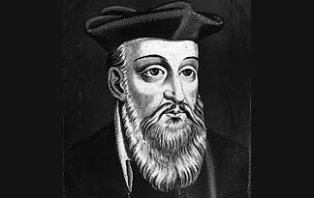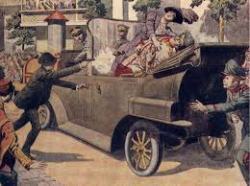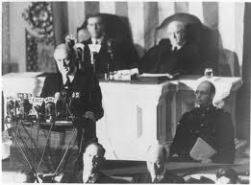72 million; Yes, 72 million is the official figure given out by the United Nations for the total number of deaths during one of the most atrocious wars history has ever seen. Out of these 72 million, about half of them, 34 million were civilian deaths. They were generally the result of carpet bombings of entire cities done by both the Allied and the Axis powers. Apart from that, one of the major sources for civilian deaths was the Holocaust perpetrated by the Nazis. All undesirable humans, except that of the Pure Nordic Aryan Race, as Hitler called it, were taken out of their homes, looted, and sent to the ghettos where they were ultimately subjected to what the Nazis called “Final Solution”.
But the atrocities during the war were only the beginning of the sufferings the whole continent would be subjected to. The main problem started after Nazi Germany surrendered in 1945. With the USA and the West European allies taking control of the western part of Germany, and the Soviet Red Army the eastern, along with taking control over parts of the Balkan states, Ukraine and Poland, a civil strife was eminent among the latter countries. And this was the origination of the stark divide in the development we see today within Europe; with the western part pushing its own limits of high economic growth, while the central Europe fighting with each other over ethnicities and getting ruled by dictatorships for significant periods, and the Eastern Europe still living in the realms and ideals of socialism and communism, which was deeply ingrained within their political system during the years of the Cold War.
But what exactly happened after the War which still has its remnants when you travel over Europe. Big, sky rise buildings in the plush cities of Frankfurt and Brussels appear to be in glaring contrast with the low-profile, undisciplined cities of Warsaw and Sarajevo. It was not only the war which had devastated the whole population, it was what followed after it which changed the whole social structure of the European States and brought about a sea change in the composition of ethnic groups living in the various European countries. Apart from that, it was the imposition of ideologies, first by the Nazis for a relatively shorter duration of time and then for a pretty long time by the Soviets, which changed how Eastern and Central Europe looked like after the War. There were many factors which brought out this change and we shall have a look at some of those
A Different Kind of War
This war was a bit different from all the preceding wars that had taken place in Europe; be it the Franco-Prussian war, the 30-Day war or the 100-Day war. In those wars, the enemy was looted, exploited and finally left alone to their own whims, but the Nazis did no such thing. The prisoners or the people of the captured land became the slave subjects of the Nazi Reich, working hard and serving the Nazi elite. They were used as workers who built tanks and weapons for the Fatherland for its war efforts. This had a huge psychological impact on the conquered people. They felt that they were not just conquered, but exploited to the core and had worked to serve the enemy in its war efforts against its own allies.
Migration Crises
One of the major elements that could have affected the social revolution was the mass exodus of people between whole nation states. Before the war had started, fearful of the intentions of Hitler, many Jews had left the country and settled across France and in a major chunk, in the Central European countries, where they already had a significant minority. This had led to an increased number of highly educated German Jews seeking for employment in the Slav States, Poland and Ukraine which needed such high skilled workers because the ethnic majority was not so educated to take up these kind of jobs. Hence, these jobs were snatched up by the migrant Jews which caused furore and hatred among the ethnic majorities and retribution was certainly on the cards.
But as the War began and the Nazis stomped their authority all over the Balkan and Poland, these Jews, along with the locals themselves, were taken to concentration camps and either exterminated or put to work. After the war, as the Soviets occupied this region, the Germans who had settled in the Balkans were taken revenge against. The whole lot of people was ousted from their respective nations and sent back to Germany.
In addition to this, the Balkan ethnicities started fighting among themselves. They wanted to carve out nation states for themselves which would have people from their own ethnicities. The Croats wanted people of their own to occupy the state of Croatia, while Hungary, Romania and Yugoslavia also tried to strive for uni-ethnicity in the country. Thus, many people were displaced off their homes, stripped off their belongings and deported to other countries.
The final blow was served by the creation of Israel in 1948. The Jews, which were still left in the Central European Nations started moving to their native place, where they rightfully belonged to. It had significant social consequences where they had been working locally as professionals – doctors, lawyers, professors, etc. With the Germans too moving out after the war, it provided a huge opportunity for the ethnic majority, the Poles, Hungarians, Croats and the Serbs to move up the social ladder and take the top jobs.
But they were a relatively inexperienced lot. Before the war, they were ruled by the kings who governed with total autocracy. Therefore, with high red-tapism and slow bureaucracy, these countries found it difficult to adjust to the changing times. There was also the heavy hand of the Soviet Russia over these countries. The rulers were highly influenced by the communist ideologies of the USSR and even the Soviet Premiers played dirty politics to keep these countries under his control as they served as key strategic locations and a buffer between the US-supportive Western Europe and USSR.
The Disturbed Administrative and Social Fabric
During the War, every state in continental Europe, was occupied by at least 2 major powers, first being the Nazis and then the Soviets. With each annexation came a breakdown in the law and order which governed the country. There were either no rules in place, which created utter chaos in the countries, or so strict laws that people constructed whole parallel underground economies which served the basic needs of all the citizens of the country. To live normally was to live by breaking the law constantly. Above everything, violence became a part of the daily life. The ultimate power to contain violence lay in the hands of the countries that ruled over them. But it was certainly a time for retribution among the locals and as a result, there were many militia and mercenary groups which emerged which sought extremist means to oust the Nazis and later, the Soviets. This led to utter disfuntioning and mistrust among the innocent civilians who wished a peaceful transition to power.
The factions allowed the Nazis and Soviets to become more cynical. They now tried to isolate people. Not only they rounded off people who were still supportive of the defunct authority, they wanted to end all bonds between individuals. There were curbs on the meeting places and any suspicion was strictly dealt with. Such was the fear that people would try various measures to get pre-emptive favour from the SS and the Gestapo forces for themselves. People went to the extent of giving out false information about their neighbours to the police so that they can get into the good books of the local authorities. Throughout 1940 and 1944, anonymous reports, plain rumours and personal accusations were strikingly high in the Eastern and Central European countries with Nazi rule.
All this had bought out a shady side of the effects of the war. The whole administrative system was demolished, there was no proper law and order, plundering was rampant; people were feeding off themselves on false information to the Gestapo. The social strand of the society had broken away and everything was haphazard. It was really difficult to raise the standard of society again, to ingrain and instil in people trust, confidence and affection towards other.
The Differential Treatment by the Nazis
The full and final blow which has now resulted in a stark contrast between the Western and the Central-Eastern countries was the relatively high support within the western European nations for the Fascist sentiments. So, when Hitler conquered France, Belgium and Netherlands, they trusted the local Fascist factions for policing within the country and deployed very less Germans (Around 1000 SS and Gestapo each) to these countries and hence, local people speaking the same language as everyone else, governed the country virtually. Hence, there was less amount of mistrust prevalent among the people after the war got over. This helped these countries get up on their feet quickly after the war. There was no exodus of people into or out of the country. The people rallied around their democratic government elected after the war and focussed on economic development rather than a social reformation.
In contrast to this, there were a lot more troops, around 2,00,000 each country, deployed to the Baltic and Polish states because they rebelled more. This, as described in the earlier section above, eroded whatever administration they had, leading to a social chaos across the strata of the society.
Thus, from the following factors, we can clearly observe that one of the main contributions of Hitler, be it for the bad or good, was to bring about a major social change in the European nations he conquered. While the Western powers were left relatively left untouched, there was large upheaval on the Eastern front, with the Soviet and the Nazis sandwiching and giving them dual blows, thus making them hard to concentrate on economic development and keeping them engrossed more in improving their social and administrative culture after the war got over. And this in turn, led to certain states turning into despotic dictatorships for a larger part of their existence. It also led to a major social up gradation and upward mobility in social strata for the people of the Slavic nations, Poland and Ukraine.
All in all, the present state of the Central and Eastern countries can be attributed majorly to the conditions that were prevalent during and after the Second World War. A social change, a revolution that was brought about, is still showing its implications and the effect of the war is still deeply rooted in the minds of the people of these countries, which was recently reflected in its opposition to the entry of immigrants from Syria.








